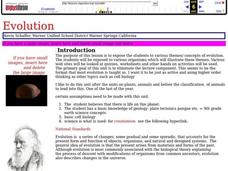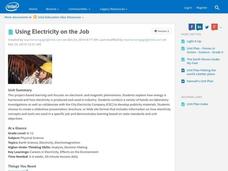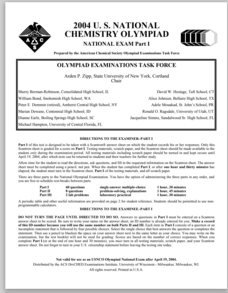Curated OER
Unit VII Energy: WS 1 Qualitative Analysis - Pie Charts
For each of eight diagrams of objects in motion, physics masters draw pie charts to depict the changes in energy. For each they must identify the energy conditions at each position. This is a unique learning exercise, perfect for...
Curated OER
Evolution
Explore the concept of evolution and cell biology; your class can work in groups to use the internet to view websites on evolution, take a quiz, and complete a lab activity.
Curated OER
Tides - The Ins and Outs of Tides
Get your junior oceanographers to generate tidal prediction graphs on an interactive website. They will feel like experts in the field, or shall we say, experts in the ocean! This is a brief, but worthwhile activity that could be used to...
Middle Tennessee State University
Who's Afraid of the Big Bad Wolf? A Comparison in American Culture
As part of their study of the Progressive Era, class groups examine a 20th century version of "The Three Little Pigs" through a New Era lens and identify how ideals such as the value of hard work, creativity, and problem solving,...
Curated OER
Double-Entry Journal Writing
Introduce your learners to the concept of a double-entry journal. Talk about how to connect with the text and model an example for them. Using whatever literature you are working with, have scholars choose a quote and make their own...
Curated OER
Norse Mythology
Are your mythology students fans of Marvel Comics or the movies, Thor and The Avengers? Planning a unit on Norse Mythology? The Eddas, Asgard, Yggdrasil, and all the gods and goddesses of the Norse tradition are included in this...
Curated OER
Vocabulary and Concept Development
Considering a lesson on Greek and Latin roots and affixes? The Latin roots bas and pos, and the Greek root bas are the focus on a colorful, animated presentation that will engage your learners and provide guided and independent practice...
Curated OER
Introduce Vocabulary: Moonbear's Bargain (Asch)
If you are reading Frank Asch's book Moonbear's Bargain, here is an excellent way to practice vocabulary in context with budding readers. Although you could include others, the recommended words for this text are: blossom,...
Curated OER
The Direct Object
What exactly is a direct object? Use this resource to introduce direct objects to your middle and early high school classrooms. The section at the top explains the part of speech, and then there are 20 sentences below for learners to...
Curated OER
Our Classroom Constitution
Develop a system of classroom rules created by the kids, for the kids with this three-part instructional activity series on the US Constitution. After learning about the structure of the Constitution and the government it...
Curated OER
Mass vs. Weight
Why do you weigh more in space? Each individual in your class explores this question and others as they determine the mass and weight of different objects using two types of scales. They perform conversions and discuss their...
Santee School District
Friendly Letter Practice Prompts
Don't get stuck trying to figuring out a topic and recipient for your informal letter writing with these six writing prompts that aid in selecting who and what to write about in a friendly letter.
Cornell University
Too Much of a Good Thing?
Continuing their study of beneficial insects, young entomologists discover where in the world some of these bugs are. By labeling, coloring, and using the scale on a map, pupils explore the territories and arrival of the Asian lady...
Intel
Using Electricity on the Job
Learners explore electricity, discussing its importance and researching different ways in which electricity can be generated. Groups present their findings to the class and then create publicity materials which promote and educate about...
University of California
Principles vs. Practices
Have you ever wondered what your own World Order would look like? Scholars use primary and secondary documents as well as video clips to investigate and analyze the Cold War. Using the sources, the principles and practices of nations...
Biology Junction
Origin of Life
Aristotle explained the idea of spontaneous generation, a concept which lasted almost 2,000 years before scientists proved it wrong. Scholars learn about the history of our understanding of the origins of life. They read examples of...
American Museum of Natural History
Tornadoes Spinning Thunderstorms
Tornado winds can reach more than 200 miles per hour. Learners explore wind speeds and more characteristics of tornadoes with an online lesson. They learn how tornadoes form and how scientists attempt to predict them. Can be used as an...
American Museum of Natural History
Volcanoes Magma Rising
Get ready for an explosive lesson! Learners read and interact with an online lesson describing the characteristics of volcanoes. They study specific historical volcanoes as well as the science of volcanic eruptions using animations and...
American Museum of Natural History
What's This?: Mythic Creatures
Fantastic beasts, and where to find them, are featured in a resource that offers images of real animals that just might have given rise to some of mythic creatures of legend.
American Museum of Natural History
The Ancient City of Petra
Anyone who has seen Indiana Jones and the Last Crusade will recognize the entrance to the Nabataean city of Petra. Young archaeologists don't need horses or camels to travel through the Sig and tour this fascinating city, however. With...
Curated OER
Module 13-Electronic Tax Return Preparation and Transmission
Students explain the electronic preparation and transmission of tax returns. They describe the ways to prepare and transmit tax returns and explain the benefits of electronic tax return preparation and transmission.
National Endowment for the Humanities
The World of Haiku
Students complete a study of Japanese culture through haiku. They read and interpret haiku poetry and write haiku of their own.
Curated OER
2004 U.S. National Chemistry Olympiad Exam Part II
In this National Chemistry Olympiad test, junior chemists answer eight problem solving questions on a variety of topics. These include calculating molarity of solutions, determining rates of reactions, calculating decay and discussing...
Curated OER
2004 U.S. National Chemistry Olympiad Part I
In this chemistry worksheet, test takers answer 60 multiple choice questions on topics related to chemistry from balancing equations to calculating moles and molecules of compounds. They name formulas, they convert, they solve problems...
Other popular searches
- Reading Spring Time
- Spring Time Bulletin Boards
- Spring Time Acrostic Poetry
- Art Spring Time
- Writing Spring Time
- April Spring Time
- Spring Time Crafts
- Art for Spring Time
- Spring Time Music
- Limericks and Spring Time
- Spring Time Climate
- Spring Time Activities























